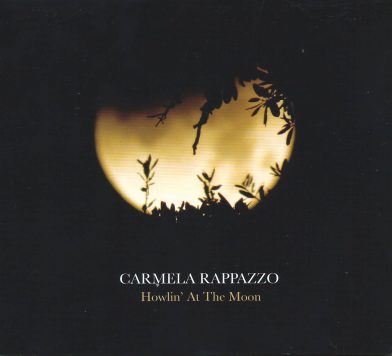Carmela Rappazzo sings a lot of blue notes. Her voice is not traditionally beautiful or “pretty.” It captures you on a different level, disconcerting yet fascinating. Rappazzo grew up in a large, Sicilian, musical family in New York and made a career for herself as an actress, first off-off-Broadway, then in Hollywood. While in L.A., she sang straightahead jazz in clubs and eventually made it to the studio, recording three albums of standards and one less traditional project including covers of Hirth Martinez, Donald Fagen and Mike Melvoin.
 Rappazzo later moved to New Mexico and back to New York, where she put out her fifth full-length and first collection of original songs, Myths and Legends. She finally settled in New Orleans last year and recorded her most recent album, Howlin’ at the Moon, at the Ellis Marsalis Center For Music, releasing it in February.
Rappazzo later moved to New Mexico and back to New York, where she put out her fifth full-length and first collection of original songs, Myths and Legends. She finally settled in New Orleans last year and recorded her most recent album, Howlin’ at the Moon, at the Ellis Marsalis Center For Music, releasing it in February.
Howlin’ at the Moon, also composed almost entirely of originals, is Rappazzo’s most ambitious project to date. This has a lot to do with the personnel she brings onboard, an ensemble of 12 of the city’s best musicians. Leading the pack are pianist Oscar Rossignoli, who is credited with directing and arranging six of the project’s nine tracks, and bassist Jasen Weaver, who is credited with the remaining three. Rossignoli’s classical training creates rich harmonies and unexpected dissonances, while Weaver’s modern jazz mentality pushes his tracks toward sparser, sleeker ground. Both approaches work to great effect and the two young musicians play off each other, tastefully comping for Rappazzo and accenting the abilities of their featured soloists, including guitarist Pete Snell, lutarist Mahmoud Chouki, trumpeter Steve Lands and saxophonist Jeronne Amari Ansari. Gerald T. Watkins’s drums, turned down to a whisper in the mix, keep pace throughout the album, providing an effortless swing that makes the whole machine run smoothly.
The songs themselves are short story-poems, telling tales of voyeurism (“Keyhole”), loss (“State of Grace”) and revenge (“Revenge”). Rappazzo showcases her talent for the written word with crystal-clear enunciation and no excessive flourishes. She sticks to the script lyrically but takes liberties with melody, singing around notes almost as often as she hits them. This technique is not immediately pleasing to the ear, but it makes for moments of tension, surprise and rare beauty, the kind only a blue note can evoke.




